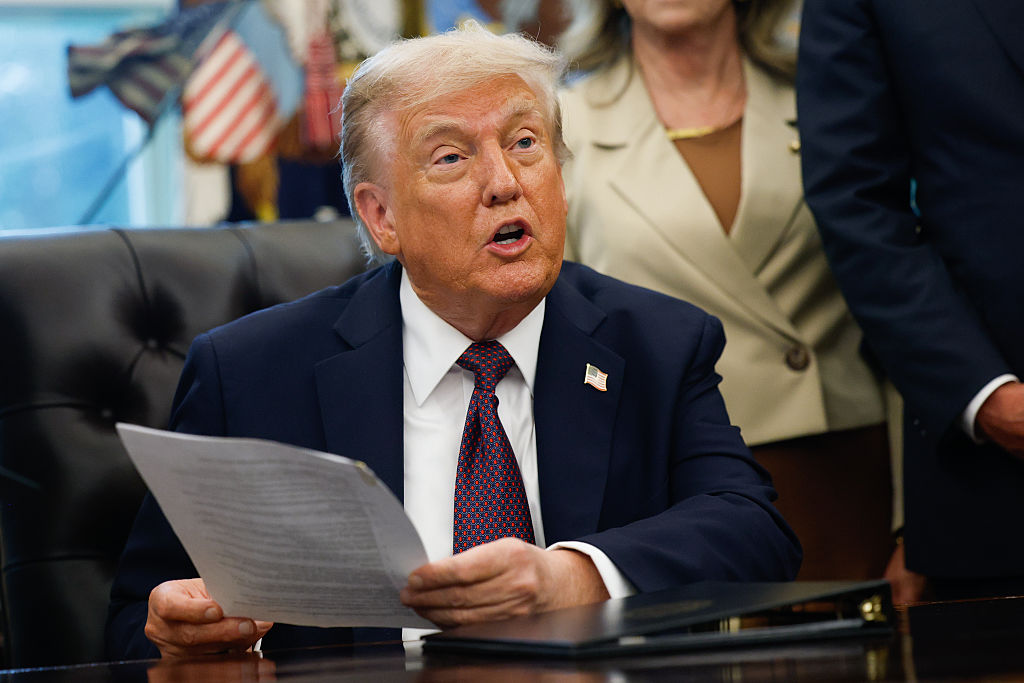The president’s power to deploy troops domestically: an explainer


Since June, President Donald Trump has ordered several National Guard deployments within the United States, often against the wishes of the Democratic governors of the states where troops are being sent. The resulting legal battles have put a spotlight on the president’s authority to federalize troops and use them domestically. How far, exactly, does this power extend?
Here’s an overview of the legal backing behind Trump’s recent deployment orders.
Where has Trump sent the National Guard?
In the past five months, Trump has sent or attempted to send National Guard troops to five cities led by Democrats: Los Angeles; Washington, D.C.; Portland, Oregon; Chicago; and Memphis, Tennessee. To justify the deployments, the president has pointed to the crime rates in those cities and the need to protect federal officials involved in immigration enforcement. For example, Trump’s Aug. 11 memorandum on mobilizing the District of Columbia National Guard said the city is “under siege from violent crime,” and that “[i]t is a point of national disgrace that Washington, D.C., has a violent crime rate that is higher than some of the most dangerous places in the world.”
Trump’s deployment orders have led to multiple legal battles. In L.A., Portland, and Chicago, the disputes primarily center on the president’s authority to federalize National Guard troops – which are traditionally under state control – and send them to U.S. cities, even after governors declined the president’s request to order such deployments. In Memphis, the conflict is between the Tennessee officials who support the deployment and those who do not, with members of the latter group challenging Gov. Bill Lee’s decision to carry out Trump’s deployment plans. In D.C., Trump has direct command over the city’s National Guard, so the key question in a lawsuit brought by the D.C. attorney general is not whether the president can deploy any troops there, but under what circumstances Trump can bring in troops from other states to supplement the local force.
What authority has Trump invoked?
The Constitution does not grant the president the authority to call military troops into domestic federal service. Article I, § 8 instead gives this power to Congress, which is tasked with “calling forth the Militia to execute the Laws of the Union, suppress Insurrections and repel Invasions.” Once Congress has issued the call, the president has the authority to command the troops under Article 2.
Just four years after the Constitution was ratified, Congress enacted the Militia Act of 1792, which gave the president the power to independently call troops into federal service to quell a foreign invasion or domestic insurrection or to stop the obstruction of the laws of the United States. This act allowed President George Washington to call up and lead state militia forces during the Whiskey Rebellion of 1794, and it is a precursor to the laws at issue in the ongoing legal battles over Trump’s deployment plans.
In a June 7 memorandum, Trump cited one such statute when he laid out his case for his authority to deploy the National Guard to U.S. cities. In that memo, he pointed to 10 U.S.C. § 12406, originally passed in 1903, which allows the president to “call into Federal service members and units of the National Guard of any State in such numbers as he considers necessary” to stop an “invasion by a foreign nation,” combat a “rebellion or danger of a rebellion” within the U.S., or “execute the laws of the United States” with regular forces.
In considering the challenges to the deployments in Los Angeles, Portland, and Chicago, federal judges have considered whether conditions in these cities met one of the latter two criteria – that is, whether they constituted a rebellion or something near a rebellion and whether officials were able to uphold U.S. laws without National Guard troops present. The Trump administration has pointed to protests, including violent confrontations with federal immigration officials, to justify the president’s invocation of Section 12406, while challengers have either said that the administration is using past conflict to justify new deployments or is generally overstating the size and violence of current protests.
The Chicago deployment is on hold since a U.S. district judge there held that it wasn’t “called for” because the situation on the ground didn’t meet either of those thresholds (though there is little case law on what constitutes such a threshold), and the U.S. Court of Appeals for the 7th Circuit agreed with that assessment.
In Los Angeles and Portland, district judges issued similar orders blocking deployment after determining that protests did not rise to the level of a rebellion and that local law enforcement officials currently were capable of enforcing the law, but the U.S. Court of Appeals for the 9th Circuit paused both orders. It concluded that courts must be highly deferential to the president’s determination that the federalization and deployment of National Guard troops was or is necessary to “execute the laws of the United States.”
Even as it has worked to convince judges that Trump’s use of Section 12406 was justified, the Justice Department has argued that such justification isn’t necessary. “As a threshold matter, this Court long ago held that ‘the authority to decide whether [an] exigency has arisen[]’ justifying the federalization of the militia ‘belongs exclusively to the President,’ whose judgment is ‘conclusive,’” contended U.S. Solicitor General D. John Sauer in his request for the Supreme Court to clear the way for the Chicago deployment, citing an 1827 case called Martin v. Mott.
What is Martin v. Mott?
The 1827 case stemmed from President James Madison’s decision to call up the New York militia during the War of 1812. When Jacob Mott failed to report for duty and then faced consequences for that decision, he challenged Madison’s order, claiming that the president didn’t have the authority to bring the New York militia into service in the first place.
As Sauer noted, the court stated in Martin v. Mott that a president’s decision to call up a state militia can’t be questioned. Specifically, the court wrote that “[w]e are all of opinion that the authority to decide whether the exigency has arisen belongs exclusively to the President, and that his decision is conclusive upon all other persons.” But not all courts agree with Sauer’s application of that ruling to today’s deployment debates.
For example, in its decision allowing the order blocking the Chicago deployment to remain in place, the 7th Circuit stated that the 1827 ruling “must be understood in its context,” which tells us that the Supreme Court wanted to prevent members of the militia from challenging a president’s deployment decisions, especially when the country was under threat from “the most powerful empire on earth,” not to prevent judicial review. According to the 7th Circuit, “The Court in Martin expressed incredulity at the prospect that every officer under the President’s command could make his own determination whether an imminent threat of invasion existed and could refuse to obey the President’s orders. … Here, by contrast, the question is whether courts, not subordinate militiamen, may review the President’s determination.”
What is the Posse Comitatus Act?
The disputes over recent deployments also have involved the Posse Comitatus Act, an 1878 law outlining what activities members of the U.S. military can undertake in U.S. cities when they’re under the president’s control. In other words, Section 12406 and similar statutes outline the circumstances under which domestic deployments can happen, while the Posse Comitatus Act places limits on what the troops can do once they’re deployed.
The Posse Comitatus Act addressed a concern that was present even among the Founders – that is, that the federal government would interfere with local law enforcement by sending federal troops to take over – but specifically responded to “abuses resulting from the extensive use of the army in civil law enforcement during the Civil War and the Reconstruction,” according to one scholar.
The act came to the forefront of the dispute over the L.A. deployment when a U.S. district judge in California held in early September that the Trump administration had violated it by using federalized National Guard troops to execute domestic law. “The evidence at trial established that Defendants systematically used armed soldiers (whose identity was often obscured by protective armor) and military vehicles to set up protective perimeters and traffic blockades, engage in crowd control, and otherwise demonstrate a military presence in and around Los Angeles,” Senior U.S. District Judge Charles Breyer wrote. That decision, which would have limited what National Guard troops could do in L.A., was put on hold with an administrative stay by the 9th Circuit, which currently is considering whether to continue blocking a different order from Breyer regarding Trump’s invocation of Section 12406 that would have barred Trump’s use of California National Guard troops in L.A. altogether.
What is the Insurrection Act?
Looming over the current deployment disputes is the possibility of Trump invoking the Insurrection Act. Like Section 12406, this law gives the president the power to federalize and deploy National Guard troops to “enforce the laws of the United States.” Unlike that other statute, it also authorizes the president to deploy members of the regular armed forces domestically, and deployments under the Insurrection Act are not subject to the limitations outlined in the Posse Comitatus Act.
Those aren’t the only difference between the two statutes. The Insurrection Act allows for deployment under a broader range of circumstances – by, for example, enabling the president to federalize troops when laws are “impracticable to enforce,” rather than only when they can’t be executed.
It also explicitly defers to the president’s judgment of whether conditions on the ground fit one of those circumstances. Specifically, it states that “[w]henever the President considers that unlawful obstructions … or rebellion against the authority of the United States make it impracticable to enforce the laws of the United States in any State by the ordinary course of judicial proceedings, he may call into Federal service such of the militia of any State, and use such of the armed forces, as he considers necessary to enforce those laws or to suppress the rebellion.”
Those differences help explain why legal experts have described the Insurrection Act as far more favorable to presidential authority. “It is based on highly permissive standards for action and provides neither a role for Congress nor a basis for serious judicial review,” wrote Bob Bauer and Jack Goldsmith in an Oct. 18 column calling on Congress to reform the act.
The Insurrection Act has been used 30 times since the country’s founding era by presidents from both parties. Presidents Dwight D. Eisenhower, John F. Kennedy, and Lyndon B. Johnson used it to send federal troops to the South to enforce desegregation orders. The Insurrection Act was last used by President George H.W. Bush in May 1992 to respond to riots in L.A.
What has Trump said about the Insurrection Act?
In recent interviews about his National Guard deployments, Trump has floated the idea of using the Insurrection Act if his efforts to use other statutes fail.
“I’m allowed, as, you know, as president. Like 50% of the presidents have used the Insurrection Act, they can use that, and everybody agrees you’re allowed to use that,” he said on Oct. 19 when speaking with reporters about the possibility of deploying troops to San Francisco. “We’re trying to do it in a nicer manner. But we can always use the Insurrection Act if we want.”
What will happen next?
The Supreme Court’s ruling on the Trump administration’s planned deployment in Chicago is expected at any time. Although the justices’ orders on the interim docket rarely include much explanation, that decision may clarify how the court views Martin v. Mott and how much deference it believes justices should give to the president when assessing whether Section 12406 has been properly invoked.
Cases: Trump v. Illinois